Deer Rubbing Tree Bark: Protecting Trees From Deer Rubs
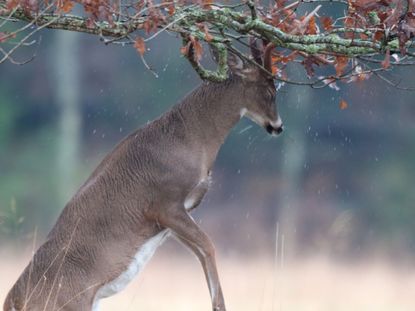

Deer are majestic creatures when they're bounding through open fields and frolicking in someone else's woods. When they come into your yard and start damaging trees, they become something else entirely. Fortunately, there are ways to protect your saplings from deer damage.
Why are Deer Rubbing Antlers on Trees?
Living close to nature can be an incredibly rewarding experience, but even the most dedicated lovers of wildlife may get pretty frustrated when they discover the local deer rubbed the bark off the trees in their yard. Not only does this behavior cause unsightly damage, it can permanently disfigure or kill young trees. Male deer (bucks) grow a new set of antlers each year, but they don't start out as the horn-like headgear that normally springs to mind. Instead, those male deer have to rub away a velvety covering in order to reveal their antlers in all their glory. This rubbing behavior typically starts in early fall, with the male deer running the surfaces of their horns against saplings that are anywhere from one to four inches (2.5 to 10 cm.) in diameter. Aside from the obvious visual deterioration, deer rubbing tree bark is very bad for the tree they're rubbing on. Peeling back just the bark can open the tree up to damage from pests and disease, but typical deer damage doesn't stop there. Once the rub has gotten through the cork layer, the delicate cambium is at risk. This tissue layer is where both xylem and phloem, the transport tissues every tree needs to survive, develop. If just one section of the tree's cambium is damaged, it might survive, but deer will often rub most of the way around a tree, causing the plant to slowly starve.
Protecting Trees from Deer Rubs
Although there are a number of popular ways to scare deer away from gardens, a determined male deer in rut isn't going to be bothered by a banging pie tin or the smell of soap hanging from your tree. To keep deer from rubbing trees, you'll need a much more hands-on approach. Tall woven wire fences are extremely effective, especially if they're erected around the tree in such a way that the deer can't jump inside and they're supported by very strong posts. Just make sure that the wire is far enough away from the tree that it can't be bent into the tree's bark if a buck were to attempt to rub through the fence - this will make the situation a lot worse. When you've got lots of trees to protect or aren't sure about building a fence around your trees, a plastic trunk wrap or strips of rubber tubing are your best bet. These materials protect the tree from deer damage without causing damage of their own when force is applied to their surfaces. If you decide to use a tree wrap, make sure it reaches a point about five feet (1.5 m.) off the ground and leave it up through the winter.
Gardening tips, videos, info and more delivered right to your inbox!
Sign up for the Gardening Know How newsletter today and receive a free download of our most popular eBook "How to Grow Delicious Tomatoes."

Kristi Waterworth was a regular contributor to Gardening Know How for many years, answering countless queries on plant pests and diseases.
-
 10 Best Apartment Plants To Turn Your Small Space Into An Oasis
10 Best Apartment Plants To Turn Your Small Space Into An OasisThe best apartment plants can lend an ambience of the tropics, brighten up a space, or add a touch of drama, and turn an apartment into a relaxing oasis.
By Amy Grant
-
 Grow a Bathroom Oasis: 8 Best Bathroom Plants With No Light or Low Light
Grow a Bathroom Oasis: 8 Best Bathroom Plants With No Light or Low LightSome apartment dwellers grow the best bathroom plants with no light or low light. Read how one of our favorite plant lovers does it in the big city.
By Teo Spengler
-
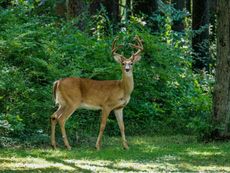 Deter Deer And Prevent Ticks By Getting Rid Of Honeysuckle
Deter Deer And Prevent Ticks By Getting Rid Of HoneysuckleWe don’t usually think of sweet-smelling honeysuckle as being unsafe, but the deer love it. and where there are deer there are often ticks. Read on for more reasons to avoid non-native honeysuckles.
By Mary Ellen Ellis
-
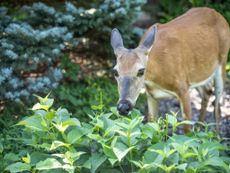 Deer Proof Shade Flowers: Choosing Deer Resistant Flowers For Shade
Deer Proof Shade Flowers: Choosing Deer Resistant Flowers For ShadeWatching deer move through your property can be a peaceful way to enjoy nature. However, they can become a nuisance if they start eating your flowers. If you have a shady garden bed, add flowers they will have no interest in. Click here to learn more.
By Mary Ellen Ellis
-
 Deer Droppings On Plants: Is Fertilizing With Deer Manure Safe
Deer Droppings On Plants: Is Fertilizing With Deer Manure SafeWhether you love or hate deer, or have a more complicated relationship with them, there is one important question to answer: Can you use deer manure in gardens? Click on the following article to find out more about fertilizing with deer manure.
By Mary Ellen Ellis
-
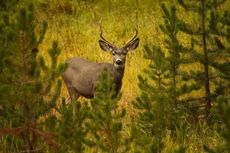 Deer Proof Evergreens: Are There Evergreens Deer Won’t Eat
Deer Proof Evergreens: Are There Evergreens Deer Won’t EatThe presence of deer in the garden can be troublesome. With some proven planting techniques, however, gardeners may be able to reduce the occurrence of damage caused by deer. Planting deer resistant evergreen plants, for example is one method. Learn more here.
By Tonya Barnett
-
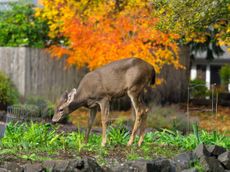 Deer Proof Gardening: What Vegetables Are Deer Resistant
Deer Proof Gardening: What Vegetables Are Deer ResistantThe best defense is a good offense. In deer proof gardening, plants that smell offensive to deer can deter them from their favorite edibles. Planting a garden with edible plants deer don't eat is also a defense. Click here for fruits and vegetables deer won't eat.
By Darcy Larum
-
 Deer Resistant Garden Plans – Creating A Deer Resistant Garden
Deer Resistant Garden Plans – Creating A Deer Resistant GardenDeer are lovely to watch but not when they are stomping all over your vegetable garden or eating the tops off of your bulbs. Creating a deer resistant garden is a must for any gardener who suffers from these grazing marauders. Learn more here.
By Bonnie L. Grant
-
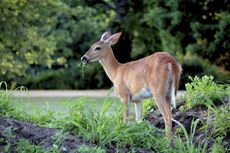 Roses And Deer – Do Deer Eat Rose Plants And How To Save Them
Roses And Deer – Do Deer Eat Rose Plants And How To Save ThemDeer do indeed love the beautiful, succulent growth they find in those meadows and valleys, but they cannot resist a rose garden if there is one close by. Learn how to fix deer damage and prevent more in this article. Click here for more info.
By Stan V. Griep
-
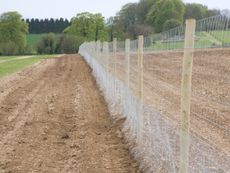 Deer Fencing Designs - How To Build A Deer Proof Fence
Deer Fencing Designs - How To Build A Deer Proof FenceDeer are elegant and graceful creatures but these attributes fall short when they have been in the garden eating your prize plants. If repellents aren't working, think about building a deer proof fence. This article will help.
By Bonnie L. Grant